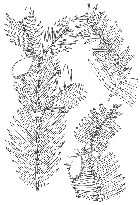
Line drawing; for full size image go to the Flora of China (Fu et al. 1999).
Cephalotaxus latifolia
宽叶粗榧 kuan ye cu fei [Chinese] (Fu et al. 1999).
"This name was invalid as originally described (as Cephalotaxus sinensis var. latifolia W. C. Cheng et L. K. Fu in W. C. Cheng et al., Acta Phytotax. Sin. 13(4): 86. 1975), and when later raised to species rank (L. K. Fu, Acta Phytotax. Sin. 22: 280. 1984), because two types (male and female) were designated. Cephalotaxus latifolia is more similar to C. harringtonii (Knight ex J. Forbes) K. Koch (C. drupacea Siebold et Zuccarini), from Japan and Korea, than to C. sinensis, with which it has been united by some authors. Cephalotaxus harringtonii has often been recorded from China (e.g., by S. Y. Hu, Taiwania 10: 25-26. 1964; A. Farjon, World Checkl. Bibliogr. Conif. 28. 1998), but apparently always as a misidentification of either C. latifolia or C. sinensis" (Fu et al. 1999).
Tree: Shrub or small tree to 5 m tall (Fu et al. 1999).
Bark: Bark grayish brown (Fu et al. 1999).
Branches: Branches stout. Leafy branchlets oblong in outline, plane, 5.5-9 × 4-5 cm (Fu et al. 1999).
Leaves: Leaves are borne at (60-)65-80(-85)° to branchlet axis, sessile but decurrent for whole length of internode. Leaf blade is dark olive green adaxially, linear, ± straight, 1.6-3 cm long × 2.8-4(-6) mm wide, thick and leathery, midvein raised adaxially and bordered on each side by a paler, longitudinal channel, strongly raised abaxially, 0.25-0.5 mm wide. Stomatal bands are white, 0.8-1 mm wide, of 11-15 rows of stomata, ca. 2-3 × as wide as midvein, marginal bands green, ca. 0.3 mm wide. Base is cuneate, slightly asymmetric, margin flat (slightly revolute when dry), apex abruptly mucronate, mucro 0.2-0.4 mm. Although its leaves usually terminate in a relatively long cusp (as in C. sinensis), occasional variants with very shortly mucronate leaves occur. These variants are similar to C. latifolia and C. mannii (C. hainanensis); their taxonomic status, and their relationship with the latter two taxa, need investigation (Fu et al. 1999).
Cones: Pollen cone capitula are axillary on lower side of branchlet axis; peduncle 1.5-2.5 mm, scaly; bracts ca. 9, ovate, in 4 rows, apical bracts ca. 0.7 × 0.3 mm, apex mucronate. Seeds cones are borne 2-6 together; peduncle is 2-4 mm long, scaly. Seeds are obovoid, 1.8-2 cm long, apex with small mucro at center (Fu et al. 1999).
Other: Pollination occurs in May (Fu et al. 1999).
China: NW Fujian, N Guangdong, NE Guangxi, SE Guizhou, SW Hubei, W Jiangxi, SE Sichuan, in thickets in mountainous areas at 900-2400 m elevation (Fu et al. 1999).
No data as of 2023.02.23.
No data as of 2023.02.23.
No data as of 2023.02.23.
The species account at Threatened Conifers of the World.
Cheng, W.C. and L.K. Fu ex L.K. Fu et al. 1999. Novon 9: 185.
Last Modified 2023-02-26